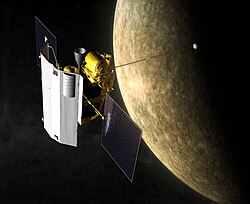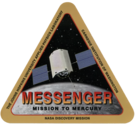
Back ماسنجر (مسبار فضائي) Arabic Месэнджар (АМС) Byelorussian МЕСИНДЖЪР Bulgarian মেসেঞ্জার (মহাকাশযান) Bengali/Bangla MESSENGER BS MESSENGER Catalan مێسنجەر (کەشتیی ئاسمانی) CKB MESSENGER Czech MESSENGER Danish MESSENGER German
 Artist's rendering of MESSENGER orbiting Mercury | |
| Mission type | Mercury probe |
|---|---|
| Operator | NASA |
| COSPAR ID | 2004-030A |
| SATCAT no. | 28391 |
| Website | messenger |
| Mission duration | Total: 10 years, 8 months and 27 days At Mercury: 4 years, 1 month and 14 days En route: 7 years Primary mission: 1 year First extension: 1 year[1][2] Second extension: 2 years[3][4] |
| Spacecraft properties | |
| Manufacturer | Applied Physics Laboratory |
| Launch mass | 1,107.9 kg (2,443 lb)[5] |
| Power | 450 watts |
| Start of mission | |
| Launch date | August 3, 2004, 06:15:56 UTC |
| Rocket | Delta II 7925H-9.5 |
| Launch site | Cape Canaveral SLC-17B |
| Entered service | April 4, 2011 |
| End of mission | |
| Disposal | Crashed into Mercury |
| Destroyed | April 30, 2015 at 19:26 UT[6] |
| Orbital parameters | |
| Reference system | Hermiocentric |
| Perihermion altitude | 200 kilometers (120 mi) |
| Apohermion altitude | 10,300 kilometers (6,400 mi) |
| Inclination | 80 degrees |
| Period | 12 hours |
| Epoch | January 1, 2000[7] |
| Flyby of Earth (gravity assist) | |
| Closest approach | August 2, 2005 |
| Distance | 2,347 kilometers (1,458 mi) |
| Flyby of Venus (gravity assist) | |
| Closest approach | October 24, 2006 |
| Distance | 2,990 kilometers (1,860 mi) |
| Flyby of Venus (gravity assist) | |
| Closest approach | June 5, 2007 |
| Distance | 337 kilometers (209 mi) |
| Flyby of Mercury | |
| Closest approach | January 14, 2008 |
| Distance | 200 kilometers (120 mi) |
| Flyby of Mercury | |
| Closest approach | October 6, 2008 |
| Distance | 200 kilometers (120 mi) |
| Flyby of Mercury | |
| Closest approach | September 29, 2009 |
| Distance | 228 kilometers (142 mi) |
| Mercury orbiter | |
| Orbital insertion | March 18, 2011, 01:00 UTC[8] |

| |
MESSENGER was a NASA robotic space probe that orbited the planet Mercury between 2011 and 2015, studying Mercury's chemical composition, geology, and magnetic field.[9][10] The name is a backronym for "Mercury Surface, Space Environment, Geochemistry, and Ranging", and a reference to the messenger god Mercury from Roman mythology.
MESSENGER was launched aboard a Delta II rocket in August 2004. Its path involved a complex series of flybys – the spacecraft flew by Earth once, Venus twice, and Mercury itself three times, allowing it to decelerate relative to Mercury using minimal fuel. During its first flyby of Mercury in January 2008, MESSENGER became the second mission, after Mariner 10 in 1975, to reach Mercury.[11][12][13]
MESSENGER entered orbit around Mercury on March 18, 2011, becoming the first spacecraft to do so.[9] It successfully completed its primary mission in 2012.[2] Following two mission extensions, the spacecraft used the last of its maneuvering propellant to deorbit, impacting the surface of Mercury on April 30, 2015.[14]
- ^ "NASA extends spacecraft's Mercury mission". UPI. November 15, 2011. Retrieved December 20, 2012.
- ^ a b Cite error: The named reference
ExMissionCompleted2013was invoked but never defined (see the help page). - ^ Wu, Brian (April 3, 2015). "NASA Set to Extend Mercury Mission for Another Month". Johns Hopkins University APL. The Science Times. Retrieved April 4, 2015.
- ^ Cowing, Keith, ed. (April 3, 2015). "MESSENGER's Operations at Mercury Extended" (Press release). Applied Physics Laboratory. Archived from the original on January 25, 2024. Retrieved April 4, 2015 – via SpaceRef.
- ^ "MESSENGER". NASA's Solar System Exploration website. Retrieved December 1, 2022.
- ^ "Beyond Earth: A Chronicle of Deep Space Exploration". NASA Solar System Exploration.
- ^ Domingue, D.L.; Russell, C.T., eds. (2007). Messenger mission to Mercury (1st ed.). New York: Springer. pp. 225–245. ISBN 9780387772141.
- ^ Lee, Jimmy; Galuska, Mike (March 18, 2011). "NASA Chats – MESSENGER Prepares to Orbit Mercury". NASA. Archived from the original on June 7, 2011. Retrieved March 18, 2011.
- ^ a b "NASA Spacecraft Circling Mercury". The New York Times. March 17, 2011. Retrieved July 9, 2013.
- ^ Wendel, J. (April 2015). "Mercury's secrets revealed by soon-to-crash spacecraft". Eos. 96. doi:10.1029/2015EO029165.
- ^ "Countdown to MESSENGER's Closest Approach with Mercury" (Press release). Johns Hopkins University. January 14, 2008. Archived from the original on May 13, 2013. Retrieved May 1, 2009.
- ^ "Critical Deep-Space Maneuver Targets MESSENGER for Its Second Mercury Encounter" (Press release). Johns Hopkins University. March 19, 2008. Archived from the original on May 13, 2013. Retrieved April 20, 2010.
- ^ "Deep-Space Maneuver Positions MESSENGER for Third Mercury Encounter" (Press release). Johns Hopkins University. December 4, 2008. Archived from the original on May 13, 2013. Retrieved April 20, 2010.
- ^ Corum, Jonathan (April 30, 2015). "Messenger's Collision Course With Mercury". The New York Times. Retrieved April 30, 2015.
© MMXXIII Rich X Search. We shall prevail. All rights reserved. Rich X Search